Overcoming Bureaucratic Resistance: An Analysis of Barriers to Climate Change Adaptation in South Africa
Abstract
1. Introduction
2. Literature Review
2.1. Theoretical Framework—Barriers to Climate Change Adaptation
2.2. Barriers to Climate Change Adaptation—A Synthesis of the Literature
3. Materials and Methods
4. Results
4.1. An Analysis of the Barriers to Climate Change Adaptation in South Africa
“The change in political parties or administration after elections is always problematic because different political parties have different priorities and oftentimes climate change is not prioritised. Thus, it is important to note that politics is a reality we must learn to navigate”.(Remark 1)
“There isn’t a united voice across government levels. It is not because people are in denial, but people are dealing with real-life issues, e.g., human settlements and service delivery. However, we need to work together. We need to find people within the different sectors to take up climate change work and work together using a bottom-up approach. We need to be proactive rather than reactive. We need to continue working at the operational level so that it cascades up”.(Remark 2)
“There are not enough funds to implement all climate change plans and projects”.(Remark 3)
“Although we receive external funding from donors, it is never enough”.(Remark 4)
“The lack of employees who are purely climate change practitioners at the local government level hinders progress”.(Remark 5)
4.2. Suggested Strategies to Overcome Barriers
- Creating awareness and educating communities on climate change issues;
- Improving coordination across the government levels and sectors;
- Ensuring that staff members that are tasked with climate change issues are well-versed in this area of expertise.
- Prioritise climate change adaptation issues to ensure that they are budgeted for appropriately;
- Source external funding from donors for all government levels in order to ensure that there are funds to implement the strategies and plans that are meant to facilitate climate change adaptation on the ground.
- Advocating for the need for the government to create a legal mandate at the local government level;
- Creating a climate change unit at the local government level;
- Increasing the human capacity to ensure that there are climate change adaptation practitioners on the ground implementing the strategies and plans that have been developed. In addition, these practitioners can play a major role in engaging with the communities, educating the communities, and driving change on the ground.
- Ensuring that the IDPs have relevant, up-to-date information on environmental issues, which can be achieved by having individuals who are well-versed in this area of expertise contribute to such important municipal documents and discussions.
- “There is room for creating more climate change adaptation awareness programmes” (Remark 6).
- “Climate change adaptation strategies, plans and programmes must be aligned across the three levels of government and across sectors which are affected by climate change” (Remark 7).
- “There is an opportunity for improved integration between the three levels of government when it comes to climate change governance” (Remark 8).
5. Discussion
6. Conclusions
Limitations and the Way Forward
Author Contributions
Funding
Institutional Review Board Statement
Informed Consent Statement
Data Availability Statement
Acknowledgments
Conflicts of Interest
References
- Intergovernmental Panel on Climate Change (IPCC). Adaptation to Climate Change in the Context of Sustainable Development and Equity. In Climate Change 2001: Impacts, Adaptation and Vulnerability; IPCC, Ed.; Cambridge University Press: Cambridge, UK, 2001. [Google Scholar]
- Intergovernmental Panel on Climate Change (IPCC). Contribution of Working Group II to the Sixth Assessment Report of the Intergovernmental Panel on Climate Change. In Climate Change 2022: Impacts, Adaptation and Vulnerability; Pörtner, H.-O., Roberts, D.C., Tignor, M., Poloczanska, E.S., Mintenbeck, K., Alegría, A., Craig, M., Langsdorf, S., Löschke, S., Möller, V., et al., Eds.; Cambridge University Press: Cambridge, UK; New York, NY, USA, 2022; p. 3056. [Google Scholar] [CrossRef]
- Balint, P.J.; Stewart, R.E.; Desai, A.; Walters, L.C. Wicked Environmental Problems: Managing Uncertainty and Conflict; Island Press: Washington, DC, USA, 2011; p. 253. [Google Scholar]
- Lazarus, R.J. Super wicked problems and climate change: Restraining the present to liberate the future. Cornell Law Rev. 2008, 94, 1153–1233. [Google Scholar]
- Turpie, J.; Visser, M. The impact of climate change on South Africa’s rural areas. In Financial and Fiscal Commission Submission for the 2013/14 Division of Revenue; Financial and Fiscal Commission: Cape Town, South Africa, 2013; pp. 100–162. [Google Scholar]
- Van der Bank, M.; Karsten, J. Climate change and South Africa: A critical analysis of the Earthlife Africa Johannesburg and another v minister of energy and others 65662/16 (2017) case and the drive for concrete climate practices. Air Soil Water Res. 2020, 13, 1178622119885372. [Google Scholar] [CrossRef]
- Savelli, E.; Rusca, M.; Cloke, H.; Di Baldassarre, G. Don’t blame the rain: Social power and the 2015–2017 drought in Cape Town. J. Hydrol. 2021, 594, 125953. [Google Scholar] [CrossRef]
- Nhamo, G.; Agyepong, A.O. Climate change adaptation and local government: Institutional complexities surrounding Cape Town’s Day Zero. Jàmbá J. Disaster Risk Stud. 2019, 11, 717. [Google Scholar] [CrossRef] [PubMed]
- David, S.G.T.; Twyman, C.; Osbahr, H.; Hewitson, B. Adaptation to climate change and variability: Farmer responses to intra-seasonal precipitation trends in South Africa. Clim. Chang. 2007, 83, 301–322. [Google Scholar]
- Hummel, D. Climate Change, Land Degradation and Migration in Mali and Senegal-Some Policy Implications, Migration and Development; Institute of Social-Ecological Research: Frankfurt, Germany, 2015. [Google Scholar]
- Skogen, K.; Helland, H.; Kaltenborn, B. Concern about climate change, biodiversity loss, habitat degradation and landscape change: Embedded in different packages of environmental concern? J. Nat. Conserv. 2018, 44, 12–20. [Google Scholar] [CrossRef]
- Sibiya, N.; Sithole, M.; Mudau, L.; Simatele, M.D. Empowering the Voiceless: Securing the Participation of Marginalised Groups in Climate Change Governance in South Africa. Sustainability 2022, 14, 7111. [Google Scholar] [CrossRef]
- Adom, R.K.; Simatele, M.D.; Reid, M. The Threats of Climate Change on Water and Food Security in South Africa. Am. J. Environ. Clim. 2022, 1, 73–91. [Google Scholar] [CrossRef]
- Biesbroek, G.R.; Swart, R.J.; Carter, T.R.; Cowan, C.; Henrichs, T.; Mela, H.; Morecroft, M.D.; Rey, D. Europe adapts to climate change: Comparing national adaptation strategies. Glob. Environ. Chang. 2010, 20, 440–450. [Google Scholar] [CrossRef]
- Keskitalo, E.C.H. (Ed.) Developing Adaptation Policy and Practice in Europe: Multi-Level Governance of Climate Change; Springer: Dordrecht, The Netherlands, 2010. [Google Scholar]
- Huitema, D.; Adger, W.N.; Berkhout, F.; Massey, E.; Mazmanian, D.; Munaretto, S.; Plummer, R.; Termeer, C.C.J.A.M. The governance of adaptation: Choices, reasons, and effects. Introduction to the Special Feature. Ecol. Soc. 2016, 21, 37. [Google Scholar] [CrossRef]
- Keping, Y. Governance and Good Governance: A New Framework for Political Analysis. Fudan J. Humanit. Soc. Sci. 2018, 11, 1–8. [Google Scholar] [CrossRef]
- Sterk, W.; Wittneben, B. Enhancing the clean development mechanism through sectoral approaches: Definitions, applications and ways forward. Int. Environ. Agreem. Politi. Law Econ. 2006, 6, 271–287. [Google Scholar] [CrossRef]
- Biermann, F. The rationale for a world environment organization. In A World Environment Organization: Solution or Threat for Effective International Environmental Governance? Biermann, F., Bauer, S., Eds.; Ashgate: Aldershot, UK, 2005; pp. 117–144. [Google Scholar]
- Dessai, S.; Schipper, E.L. The Marrakech accords to the Kyoto Protocol: Analysis and future prospects. Glob. Environ. Chang. 2003, 13, 149–153. [Google Scholar] [CrossRef]
- Grubb, M.; Yamin, F. Climatic collapse at The Hague: What happened, why, and where do we go from here? Int. Aff. 2001, 77, 261–276. [Google Scholar] [CrossRef]
- Ortega-Cisneros, K.; Cochrane, K.L.; Rivers, N.; Sauer, W.H.H. Assessing South Africa’s Potential to Address Climate Change Impacts and Adaptation in the Fisheries Sector. Front. Mar. Sci. 2021, 8, 652955. [Google Scholar] [CrossRef]
- Alemaw, B.F.; Simatele, D. Integrating Climate Change Adaptation and Mitigation into Sustainable Development Planning: The Policy Dimension. In Climate Variability and Change in Africa; Sustainable Development Goals Series; Matondo, J.I., Alemaw, B.F., Sandwidi, W.J.P., Eds.; Springer: Cham, Switzerland, 2020. [Google Scholar]
- Cockburn, I.; Henderson, R.; Stern, S. The impact of artificial intelligence on innovation. In The Economics of Artificial Intelligence: An Agenda; Agrawal, A., Gans, J., Goldfarb, A., Eds.; University of Chicago Press and NBER: Chicago, IL, USA, 2019. [Google Scholar]
- Rijke, J.; Brown, R.; Zevenbergen, C.; Ashley, R.; Farrelly, M.; Morison, P.; van Herk, S. Fit-for-purpose governance: A framework to make adaptive governance operational. Environ. Sci. Policy 2012, 22, 73–84. [Google Scholar] [CrossRef]
- Moser, S.C.; Ekstrom, J.A. A framework to diagnose barriers to climate change adaptation. Proc. Natl. Acad. Sci. USA 2010, 107, 22026–22031. [Google Scholar] [CrossRef]
- Adger, W.N.; Barnett, J. Four Reasons for Concern about Adaptation to Climate Change. Environ. Plan. A Econ. Space 2009, 41, 2800–2805. [Google Scholar] [CrossRef]
- Adger, W.N.; Eakin, H.; Winkels, A. Nested and teleconnected vulnerabilities to environmental change. Front. Ecol. Environ. 2009, 7, 150–157. [Google Scholar] [CrossRef]
- Adger, W.N.; Agrawala, S.; Mirza, M.M.Q.; Conde, C.; O’Brien, K.; Pulhin, J.; Pulwarty, R.; Smit, B.; Takahashi, K. Assessment of Adaptation Practices, Options, Constraints and Capacity. In Climate Change 2007: Impacts, Adaptation and Vulnerability; Contribution of Working Group II to the Fourth Assessment Report of the Intergovernmental Panel on Climate Change; Parry, M.L., Canziani, O.F., Palutikof, J.P., van der Linden, P.J., Hanson, C.E., Eds.; Cambridge University Press: Cambridge, UK, 2007; pp. 717–743. [Google Scholar]
- Klaus, E.; Susanne, C.M.; Esther, H.; Richard, K.; Christoph, O.; Anna, P.; Maja, R.; Catrien, T. Explaining and overcoming barriers to climate change adaptation. Nat. Clim. Chang. 2014, 4, 867–872. [Google Scholar]
- Falaleeva, M.; O’Mahony, C.; Gray, S.; Desmond, M.; Gault, J.; Cummins, V. Towards climate adaptation and coastal governance in Ireland: Integrated architecture for effective management? Mar. Policy 2011, 35, 784–793. [Google Scholar] [CrossRef]
- Biesbroek, R.; Klostermann, J.; Termeer, C.; Kabat, P. Barriers to climate change adaptation in the Netherlands. Clim. Law 2011, 2, 181–199. [Google Scholar] [CrossRef]
- Mukheibir, P.; Kuruppu, N.; Gero, A.; Herriman, J. Cross-Scale Barriers to Climate Change Adaptation in Local Government, Australia; National Climate Change Adaptation Research Facility: Gold Coast, Australia, 2013; p. 95. [Google Scholar]
- Anderies, J.M.; Janssen, M.A.; Ostrom, E. A framework to analyze the robustness of social-ecological systems from an institutional perspective. Ecol. Soc. 2004, 9, 18. [Google Scholar] [CrossRef]
- Berkes, F. Restoring unity: The concept of marine social-ecological systems. In World Fisheries: A Social-Ecological Analysis; Ommer, R., Perry, I., Cochrane, K.L., Cury, P., Eds.; Wiley-Blackwells: Oxford, UK, 2011; pp. 9–28. [Google Scholar] [CrossRef]
- Hooghe, L.; Marks, G. Multi-Level Governance and European Integration; Rowman & Littlefield: Boulder, CO, USA, 2001. [Google Scholar]
- Fairbrass, J.; Jordan, A. European Union environmental policy and the role of the UK government: Passive observer or strategic manager. Environ. Politics 2001, 10, 1–21. [Google Scholar] [CrossRef]
- Ostrom, E. Polycentric systems for coping with collective action and global environmental change. Glob. Environ. Chang. 2010, 20, 550–557. [Google Scholar] [CrossRef]
- Ekstrom, J.A.; Moser, S.C. Identifying and overcoming barriers in urban climate adaptation: Case study findings from the San Francisco Bay Area, California, USA. Urban Clim. 2014, 9, 54–74. [Google Scholar] [CrossRef]
- HMG. The National Adaptation Programme: Making the Country Resilient to a Changing Climate; Analytical Annex: Economics of the National Adaptation Programme; Her Majesty’s Government (HMG), Stationery Office: London, UK, 2013. [Google Scholar]
- Cimato, F.; Mullan, M. Adapting to Climate Change: Analysing the Role of Government; DEFRA Evidence and Analysis Series Paper 1; Department for Environment, Food and Rural Affairs (DEFRA): London, UK, 2010.
- Ngwenya, N.; Simatele, M.D. The emergence of green bonds as an integral component of climate finance in South Africa. S. Afr. J. Sci. 2020, 116, 25–27. [Google Scholar] [CrossRef] [PubMed]
- Serdeczny, O.; Adams, S.; Baarsch, F.; Coumou, D.; Robinson, A.; Hare, W.; Schaeffer, M.; Perrette, M.; Reinhardt, J. Climate change impacts in Sub-Saharan Africa: From physical changes to their social repercussions. Reg. Environ. Chang. 2017, 17, 1585–1600. [Google Scholar] [CrossRef]
- Roberts, D. Thinking globally, acting locally Institutionalizing climate change at the local government level in Durban, South Africa. Environ. Urban. 2008, 20, 521–537. [Google Scholar] [CrossRef]
- Peters, B.G. Policy capacity in public administration. Policy Soc. 2015, 34, 219–228. [Google Scholar] [CrossRef]
- Cullmann, J.; Dilley, M.; Egerton, P.; Fowler, J.; Grasso, V.F.; Honoré, C.; Lúcio, F.; Luterbacher, J.; Nullis, C.; Power, M.; et al. 2020 State of Climate Services; Risk Information and Early Warning Systems; World Meteorological Organization: Geneva, Switzerland, 2020. [Google Scholar]
- Ryan, D.; Bustos, E. Knowledge gaps and climate adaptation policy: A comparative analysis of six Latin American countries. Clim. Policy 2019, 19, 1297–1309. [Google Scholar] [CrossRef]
- Mohmand, S.K.; Loureiro, M. Introduction: Interrogating Decentralisation in Africa. 2017. Available online: https://bulletin.ids.ac.uk/index.php/idsbo/article/view/2856/ONLINE%20ARTICLE (accessed on 29 January 2023).
- Ampaire, E.L.; Jassogne, L.; Providence, H.; Acosta, M.; Twyman, J.; Winowiecki, L.; van Asten, P. Institutional challenges to climate change adaptation: A case study on policy action gaps in Uganda. Environ. Sci. Policy 2017, 75, 81–90. [Google Scholar] [CrossRef]
- Timilsina, G.R. Financing Climate Change Adaptation: International Initiatives. Sustainability 2021, 13, 6515. [Google Scholar] [CrossRef]
- Gujba, H.; Thorne, S.; Mulugetta, Y.; Rai, K.; Sokona, Y. Financing low carbon energy access in Africa. Energy Policy 2012, 47, 71–78. [Google Scholar] [CrossRef]
- Aligishiev, Z.; Bellon, M.; Massetti, E. MacroFiscal Implications of Adaptation to Climate Change; IMF Staff Climate Note 2022/002; International Monetary Fund: Washington, DC, USA, 2022. [Google Scholar]
- United Nations Environment Programme. Future Proofing Infrastructure to Address the Climate, Biodiversity and Pollution Crises; UNEP: Nairobi, Kenya, 2021. [Google Scholar]
- Donner, L.J.; Wyman, B.L.; Hemler, R.S.; Horowitz, L.W.; Ming, Y.; Zhao, M.; Golaz, J.-C.; Ginoux, P.; Lin, S.-J.; Schwarzkopf, M.D.; et al. The dynamical core, physical parameterizations, and basic simulation characteristics of the atmospheric component AM3 of the GFDL global coupled model CM3. J. Clim. 2011, 24, 3484–3519. [Google Scholar] [CrossRef]
- Fankhauser, S.; Schmidt-Traub, G. From adaptation to climate-resilient development. The cost of climateproofing the Millennium Development Goals in Africa. Clim. Dev. 2011, 3, 1–20. [Google Scholar] [CrossRef]
- Dannevig, H.; Rauken, T.; Hovelsrud, G. Implementing adaptation to climate change at the local level. Local Environ. 2012, 17, 597–611. [Google Scholar] [CrossRef]
- Anguelovski, I.; Carmin, J. Something borrowed, everything new: Innovation and institutionalization in urban climate governance. Curr. Opin. Environ. Sustain. 2011, 3, 169–175. [Google Scholar] [CrossRef]
- Runhaar, H.; Mees, H.; Wardekker, A.; van der Sluijs, J.; Driessen, P.P.J. Adaptation to climate change-related risks in Dutch urban areas: Stimuli and barriers. Reg. Environ. Chang. 2012, 12, 777–790. [Google Scholar] [CrossRef]
- Larsen, S.V.; Kørnøv, L.; Wejs, A. Mind the gap in SEA: An institutional perspective on why assessment of synergies amongst climate change mitigation, adaptation and other policy areas are missing. Environ. Impact Assess. Rev. 2012, 33, 32–40. [Google Scholar] [CrossRef]
- Wilby, R.L.; Keenan, R. Adapting to flood risk under climate change. Prog. Phys. Geogr. Earth Environ. 2012, 36, 348–378. [Google Scholar] [CrossRef]
- Burch, S. Transforming barriers into enablers of action on climate change: Insights from three municipal case studies in British Columbia, Canada. Glob. Environ. Chang. 2010, 20, 287–297. [Google Scholar] [CrossRef]
- Roberts, D. Prioritizing climate change adaptation and local level resilience in Durban, South Africa. Environ. Urban. 2010, 22, 397–413. [Google Scholar] [CrossRef]
- Storbjörk, S. ‘It Takes More to Get a Ship to Change Course’: Barriers for Organizational Learning and Local Climate Adaptation in Sweden. J. Environ. Policy Plan. 2010, 12, 235–254. [Google Scholar] [CrossRef]
- Amundsen, H.; Berglund, F.; Westskogs, H. Overcoming Barriers to Climate Change Adaptation—A question of multi-level governance? Environ. Plan. C Gov. Policy 2010, 28, 276–289. [Google Scholar] [CrossRef]
- United Nations Environment Programme. Annual Report. 2022. Available online: https://www.unep.org/resources/annual-report-2022 (accessed on 21 April 2023).
- Taljaard, S.; van Niekerk, L.; Weerts, S.P. The legal landscape governing South Africa’s coastal marine environment—Helpingwith the ‘horrendogram’. Ocean. Coast. Manag. 2019, 178, 104801. [Google Scholar] [CrossRef]
- Ampaire, L.; Muhindo, A.; Orikiriza, P.; Mwanga-Amumpaire, J.; Bebell, L.; Boum, Y. A review of antimicrobial resistance in East Africa. Afr. J. Lab. Med. 2016, 5, a432. [Google Scholar] [CrossRef]
- Füssel, H.-M. Adaptation planning for climate change: Concepts, assessment approaches, and key lessons. Sustain. Sci. 2007, 2, 265–275. [Google Scholar] [CrossRef]
- Smit, B.; Pilifosova, O. From adaptation to adaptive capacity and vulnerability reduction. In Climate Change, Adaptive Capacity, and Development; Smith, J.B., Klein, R.J.T., Huq, S., Eds.; Imperial College Press: London, UK, 2003; pp. 9–28. [Google Scholar]
- Mossler, M.V.; Bostrom, A.; Kelly, R.P.; Crosman, K.M.; Moy, P. How does framing affect policy support for emissions mitigation? Testing the effects of ocean acidification and other carbon emissions frames. Glob. Environ. Chang. 2017, 45, 63–78. [Google Scholar] [CrossRef]
- Füssel, H.M.; Kurnik, B.; Tomescu, M.; Vanneuville, W.; Smith, M.; Gerber, F.; Artola, I.; Adriaenssens, V.; Bigano, A.; Vingerhouts, P.; et al. Adaptation Challenges and Opportunities for the European Energy System: Building a Climate-Resilient Low-Carbon Energy System; EEA Report No 01/2019; Publications Office of the European Union: Luxembourg, 2019.
- Smith, T.F.; Preston, B.; Brooke, C.; Gorddard, R.; Abbs, D.; McInnes, K.; Withycombe, G.; Morrison, C.; Beveridge, B.; Measham, T.G. Managing coastal vulnerability: New solutions for local government. In Integrated Coastal Zone Management; Moksness, E., Dahl, E., Støttrup, J.G., Eds.; Wiley-Blackwell: West Sussex, UK, 2009. [Google Scholar]
- Clement, F.; Amezaga, J.M. Afforestation and forestry land allocation in northern Vietnam: Analysing the gap between policy intentions and outcomes. Land Use Policy 2009, 26, 458–470. [Google Scholar] [CrossRef]
- Keen, M.; Mahanty, S.; Sauvage, J. Sustainability assessment and local government: Achieving innovation through practitioner networks. Local Environ. 2006, 11, 201–216. [Google Scholar] [CrossRef]
- Measham, T.G.; Preston, B.L.; Smith, T.F.; Brooke, C.; Gorddard, R.; Withycombe, G.; Morrison, C. Adapting to climate change through local municipal planning: Barriers and challenges. Mitig. Adapt. Strat. Glob. Chang. 2011, 16, 889–909. [Google Scholar] [CrossRef]
- Wilhelm-Rechmann, A.; Cowling, R.M. Local land-use planning and the role of conservation: An example analysing opportunities. S. Afr. J. Sci. 2013, 109, 1–6. [Google Scholar] [CrossRef]
- Hardoy, J.; Lankao, P.R. Latin American cities and climate change: Challenges and options to mitigation and adaptation responses. Curr. Opin. Environ. Sustain. 2011, 3, 158–163. [Google Scholar] [CrossRef]
- Ziervogel, G.; Parnell, S. South African Coastal Cities: Governance Responses to Climate Change Adaptation. Climate Change at the City Scale, Impacts, Mitigation and Adaptation in Cape Town; Cartwright, A., Parnell, S., Oelofse, G., Ward, S., Eds.; Routledge: Abingdon, UK, 2012. [Google Scholar]
- Dalal-Clayton, B.; Bass, S. The Challenges of Environmental Mainstreaming: Experience of Integrating Environment into Development Institutions and Decisions; Environmental Governance No. 3; International Institute for Environment and Development: London, UK, 2009. [Google Scholar]
- Preston, B.L.; Dow, K.; Berkhout, F. The Climate Adaptation Frontier. Sustainability 2013, 5, 1011–1035. [Google Scholar] [CrossRef]
- Hepworth, N. Climate Change Vulnerability and Adaptation Preparedness in Uganda; Heinrich Böll Stiftung, Regional Office for East and Horn of Africa: Nairobi, Kenya, 2010. [Google Scholar]
- Rwakakamba, T.M. Examining the nexus between depletion of water catchments systems and the deepening water crisis in Uganda. IOP Conf. Ser. Earth Environ. Sci. 2009, 6, 292049. [Google Scholar] [CrossRef]
- Friis-Hansen, E.; Bashaasha, B.; Aben, C. Decentralization and Implementation of Climate Change Policy in Uganda. DIIS Working Paper 27. 2013. Available online: https://www.diis.dk/files/media/publications/import/extra/wp2013-17_ccri_uganda_efh_web.pdf (accessed on 3 December 2022).
- Orindi, V.A. Evaluation of the Status of NAPA/NAP in Ethiopia, Tanzania, Uganda and Kenya; Climate Change Agriculture and Food Security (CCAFS); ECBI: Sydney, NSW, Australia, 2013. [Google Scholar]
- Madzwamuse, M. Drowning voices: The climate change discourse in South Africa. Policy Brief 2010, 5, 1–8. [Google Scholar]
- Nowell, L.S.; Norris, J.M.; White, D.E.; Moules, N.J. Thematic Analysis: Striving to Meet the Trustworthiness Criteria. Int. J. Qual. Methods 2017, 16, 1–13. [Google Scholar] [CrossRef]
- Braun, V.; Clarke, V. Using thematic analysis in psychology. Qual. Res. Psychol. 2006, 3, 77–101. [Google Scholar] [CrossRef]
- Averchenkova, A.; Gannon, K.E.; Patrick, C. Governance of Climate Change Policy: A Case Study of South Africa; Grantham Research Institute on Climate Change and the Environment and Centre for Climate Change Economics and Policy: London, UK; London School of Economics and Political Science: London, UK, 2019. [Google Scholar]
- National Treasury. Annual Report; Republic of South Africa. 2016. Available online: https://www.treasury.gov.za/publications/annual%20reports/national%20treasury/nt%20annual%20report%202016-17.pdf (accessed on 15 November 2022).
- Hooli, L.J. Resilience of the poorest: Coping strategies and indigenous knowledge of living with the floods in Northern Namibia. Reg. Environ. Chang. 2016, 16, 695–707. [Google Scholar] [CrossRef]
- Pressend, M. Financial barriers to adaptation implementation: A South African case study on financing water adaptation. In Overcoming Barriers to Climate Change Adaptation Implementation in Southern Africa; Masters, L., Duff, L., Eds.; Africa Institute of South Africa: Pretoria, South Africa, 2011; pp. 163–179. [Google Scholar]
- Goebel, J.M. Risk, return, and performance measurement: A case of unrealistic expectations? Risk Manag. Insur. Rev. 2007, 10, 51–68. [Google Scholar] [CrossRef]
- CoGTA. Annual Report 2009/2010. National Disaster Management Centre Cooperative Governance & Traditional Affairs. Available online: https://www.cogta.gov.za/cgta_2016/wp-content/uploads/2016/06/NDMC-ANNUAL-REPORT-2009-2010-FINAL-14-May-2012.pdf (accessed on 25 November 2022).
- Khambule, I. Imagining an Institutionalised Social Dialogue in the South African Local Government-Led Development Landscape. Forum Dev. Stud. 2018, 45, 97–117. [Google Scholar] [CrossRef]
- Scoville-Simonds, M.; Jamali, H.; Hufty, M. The Hazards of Mainstreaming: Climate change adaptation politics in three dimensions. World Dev. 2020, 125, 104683. [Google Scholar] [CrossRef]
- Mapfumo, P.; Onyango, M.; Honkponou, S.K.; El Mzouri, E.H.; Githeko, A.; Rabeharisoa, L.; Obando, J.; Omolo, N.; Majule, A.; Denton, F.; et al. Pathways to transformational change in the face of climate impacts: An analytical framework. Clim. Dev. 2017, 9, 439–451. [Google Scholar] [CrossRef]
- Ross, H.; Shaw, S.; Rissik, D.; Cliffe, N.; Chapman, S.; Hounsell, V.; Udy, J.; Trinh, N.T.; Schoeman, J. A participatory systems approach to understanding climate adaptation needs. Clim. Chang. 2015, 129, 27–42. [Google Scholar] [CrossRef]
- Lemos, M.C.; Kirchhoff, C.J.; Ramprasad, V. Narrowing the climate information usability gap. Nat. Clim. Chang. 2012, 2, 789–794. [Google Scholar] [CrossRef]
- Kirchhoff, C.J. Understanding and enhancing climate information use in water management. Clim. Chang. 2013, 119, 495–509. [Google Scholar] [CrossRef]
- Roncoli, C.; Jost, C.; Kirshen, P.; Sanon, M.; Ingram, K.T.; Woodin, M.; Somé, L.; Ouattara, F.; Sanfo, B.J.; Sia, C.; et al. From accessing to assessing forecasts: An end-to-end study of participatory climate forecast dissemination in Burkina Faso (West Africa). Clim. Chang. 2009, 92, 433–460. [Google Scholar] [CrossRef]
- Pagano, T.; Hartmann, H.; Sorooshian, S. Factors affecting seasonal forecast use in Arizona water management: A case study of the 1997-98 El Niño. Clim. Res. 2002, 21, 259–269. [Google Scholar] [CrossRef]
- Power, S.; Sadler, B.; Nicholls, N. The Influence of Climate Science on Water Management in Western Australia: Lessons for Climate Scientists. Bull. Am. Meteorol. Soc. 2005, 86, 839–844. [Google Scholar] [CrossRef]
- Loring, P.A.; Gerlach, S.C.; Atkinson, D.E.; Murray, M.S. Ways to help and ways to hinder: Governance for successful livelihoods in changing climate. Artic 2011, 64, 73–88. [Google Scholar]
- Owen, S. Learning across levels of governance: Expert advice and the adoption of carbon dioxide emissions reduction targets in the UK. Glob. Environ. Chang. 2010, 20, 394–401. [Google Scholar] [CrossRef]
- Keskitalo, E.C.H.; Kulyasova, A.A. The role of governance in community adaptation to climate change. Polar Res. 2009, 28, 60–70. [Google Scholar] [CrossRef]
- Mpandeli, S.; Naidoo, D.; Mabhaudhi, T.; Nhemachena, C.; Nhamo, L.; Liphadzi, S.; Hlahla, S.; Modi, A.T. Climate Change Adaptation through the Water-Energy-Food Nexus in Southern Africa. Int. J. Environ. Res. Public Health 2018, 15, 2306. [Google Scholar] [CrossRef]
- Du Plessis, A.A.; Kotzé, L.J. The Heat is on: Local Government and Climate Governance in South Africa. J. Afr. Law 2014, 58, 145–174. [Google Scholar] [CrossRef]
- Alemaw, B.F. Framework of best practice for climate change adaptation in Africa: The water–development nexus. In Climate Variability and Change in Africa: Perspectives, Experiences and Sustainability; Sustainable Development Goals Series; Springer: Cham, Switzerland, 2020. [Google Scholar] [CrossRef]
- Baarsch, F.; Granadillos, J.R.; Hare, W.; Knaus, M.; Krapp, M.; Schaeffer, M.; Lotze-Campen, H. The impact of climate change on incomes and convergence in Africa. World Dev. 2020, 126, 104699. [Google Scholar] [CrossRef]
- Cacho, O.J.; Moss, J.; Thornton, P.K.; Herrero, M.; Henderson, B.; Bodirsky, B.L.; Humpenöder, F.; Popp, A.; Lipper, L. The value of climate-resilient seeds for smallholder adaptation in sub-Saharan Africa. Clim. Chang. 2020, 162, 1213–1229. [Google Scholar] [CrossRef]
- Biermann, F.; Bai, X.; Bondre, N.; Broadgate, W.; Chen, C.-T.A.; Dube, O.P.; Erisman, J.W.; Glaser, M.; van der Hel, S.; Lemos, M.C.; et al. Down to earth: Contextualizing the Anthropocene. Glob. Environ. Chang. 2016, 39, 341–350. [Google Scholar] [CrossRef]
- Ostrom, E.; Janssen, M.A. Multi-Level Governance and Resilience of Social-Ecological Systems. In Globalisation, Poverty and Conflict: A Critical “Development” Reader; Spoor, M., Ed.; Springer: Dordrecht, The Netherlands, 2005; pp. 239–259. [Google Scholar]
- Serrao-Neumann, S.; Harman, B.P.; Choy, D.L. The Role of Anticipatory Governance in Local Climate Adaptation: Observations from Australia. Plan. Pract. Res. 2013, 28, 440–463. [Google Scholar] [CrossRef]
- Hobbs, R.J.; Hallett, L.M.; Ehrlich, P.R.; Mooney, H.A. Intervention Ecology: Applying Ecological Science in the Twenty-first Century. BioScience 2011, 61, 442–450. [Google Scholar] [CrossRef]
- Araújo, M.B.; Alagador, D.; Cabeza, M.; Nogués-Bravo, D.; Thuiller, W. Climate change threatens European conservation areas: Climate change threatens conservation areas. Ecol. Lett. 2011, 14, 484–492. [Google Scholar] [CrossRef] [PubMed]
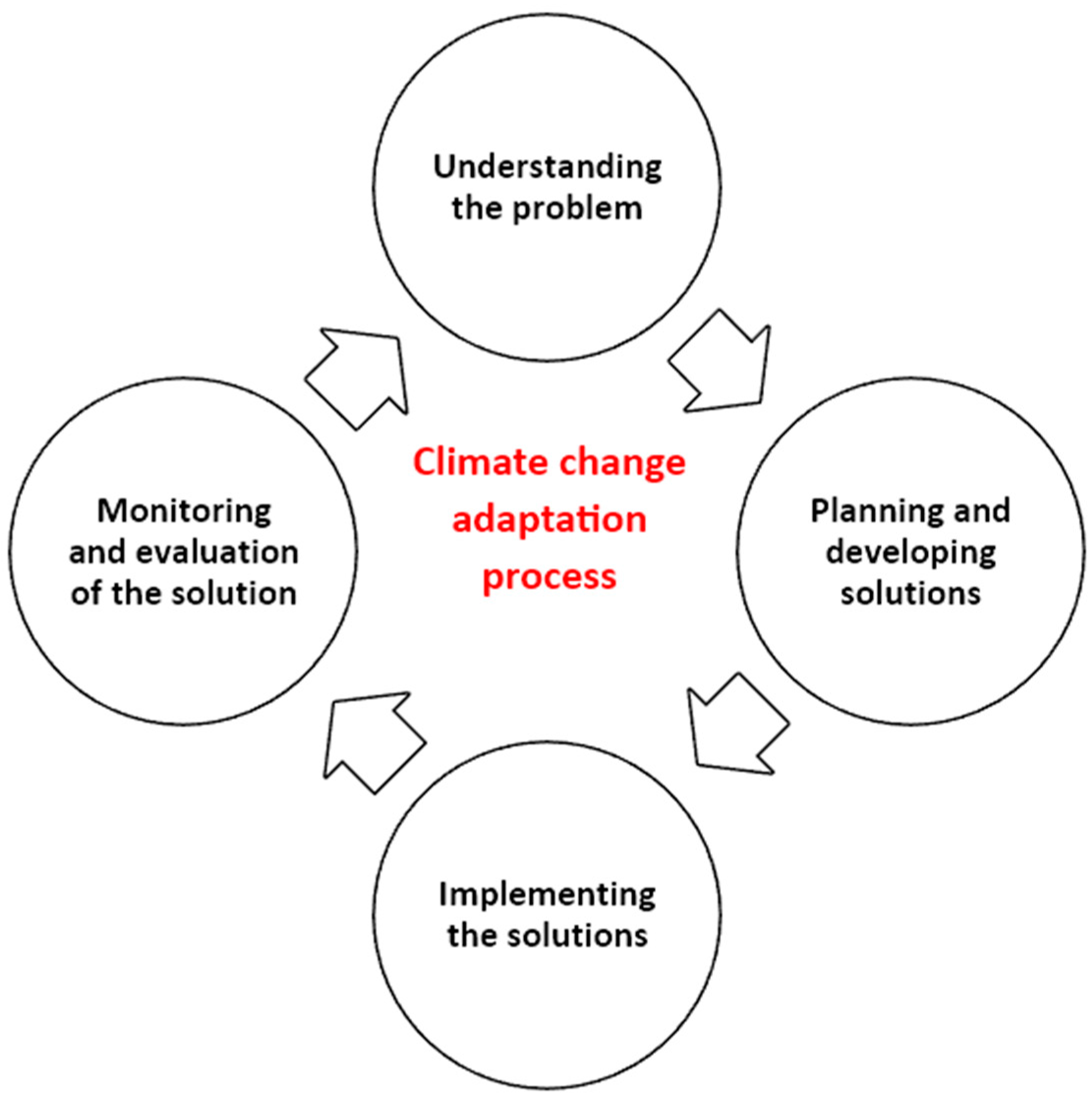
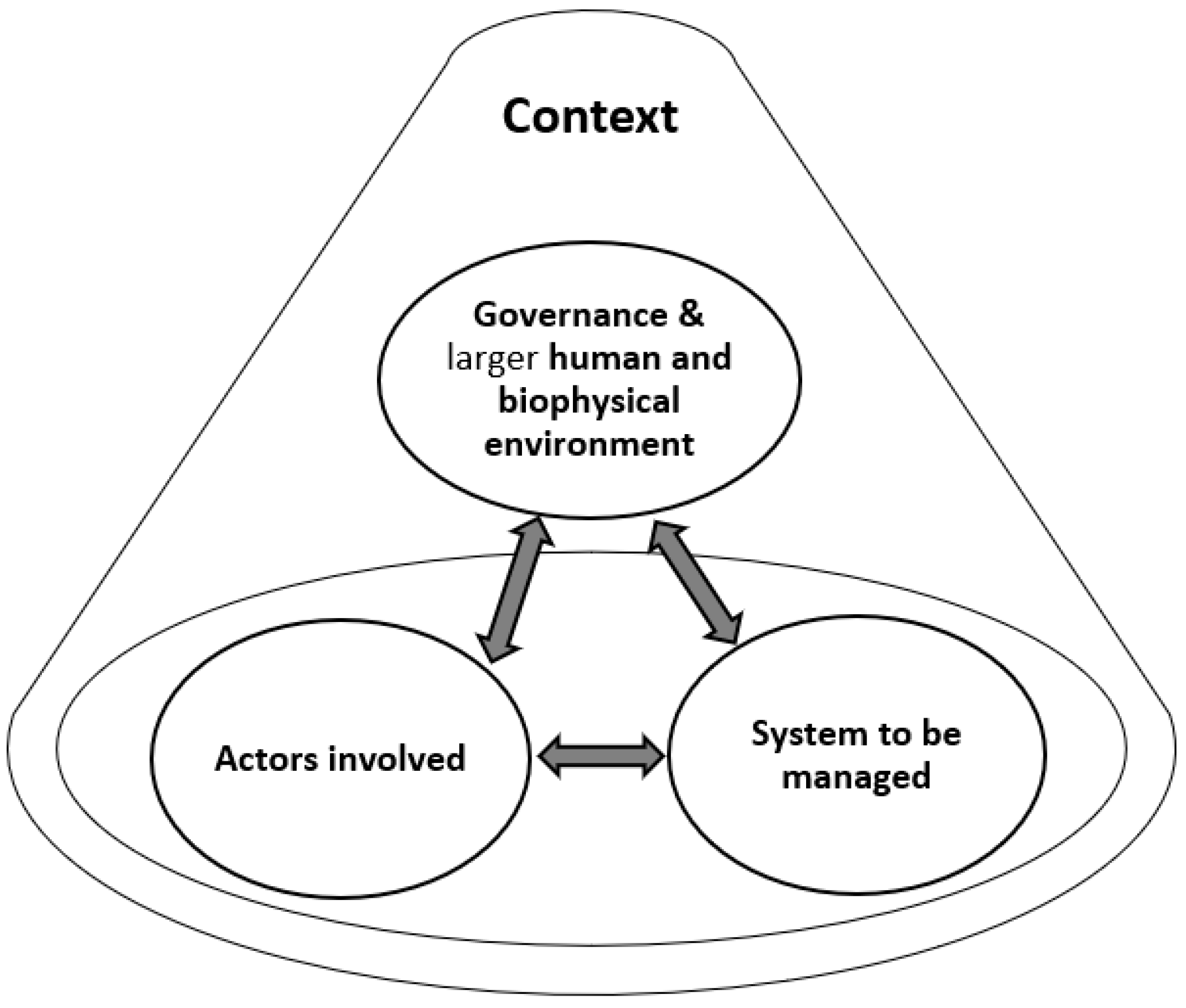
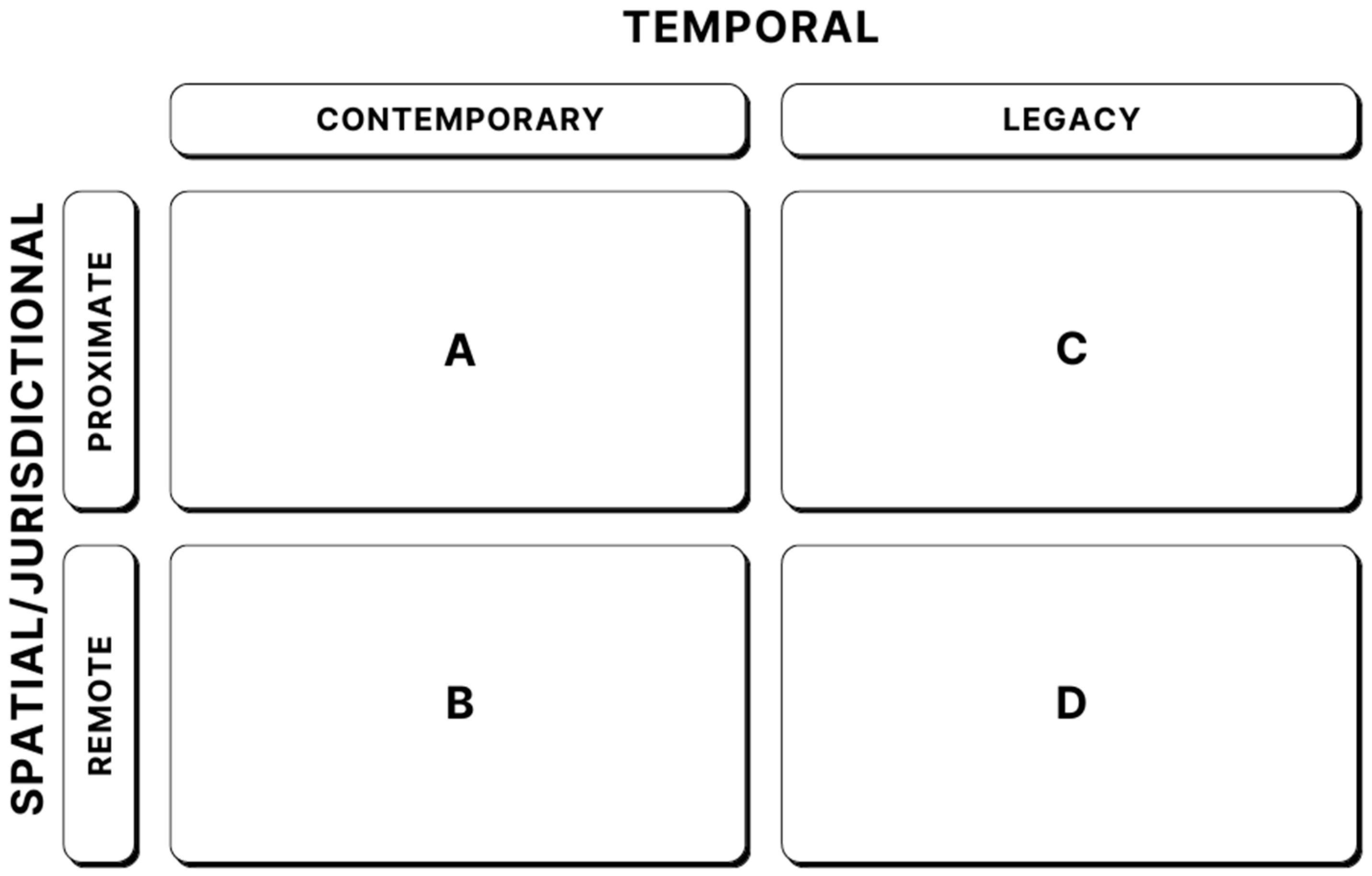
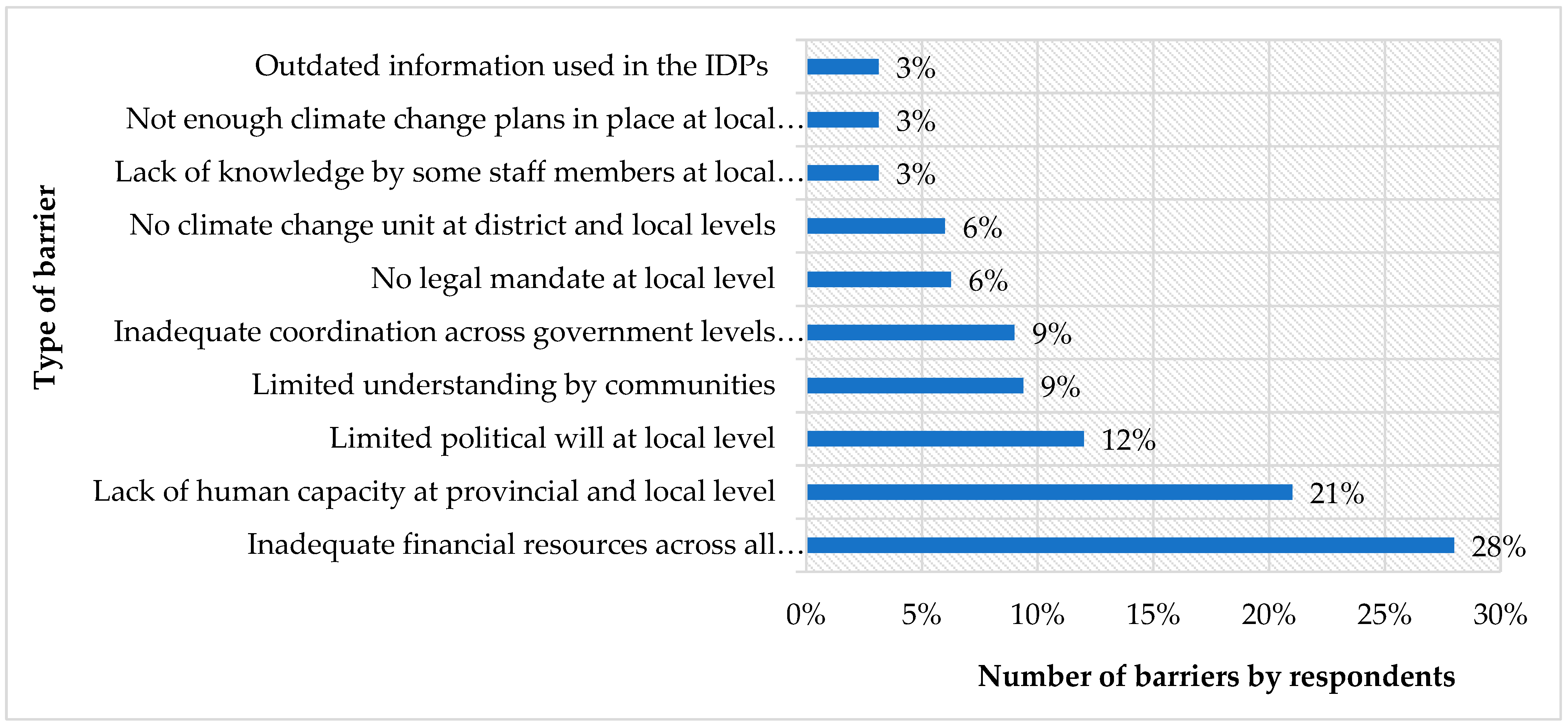
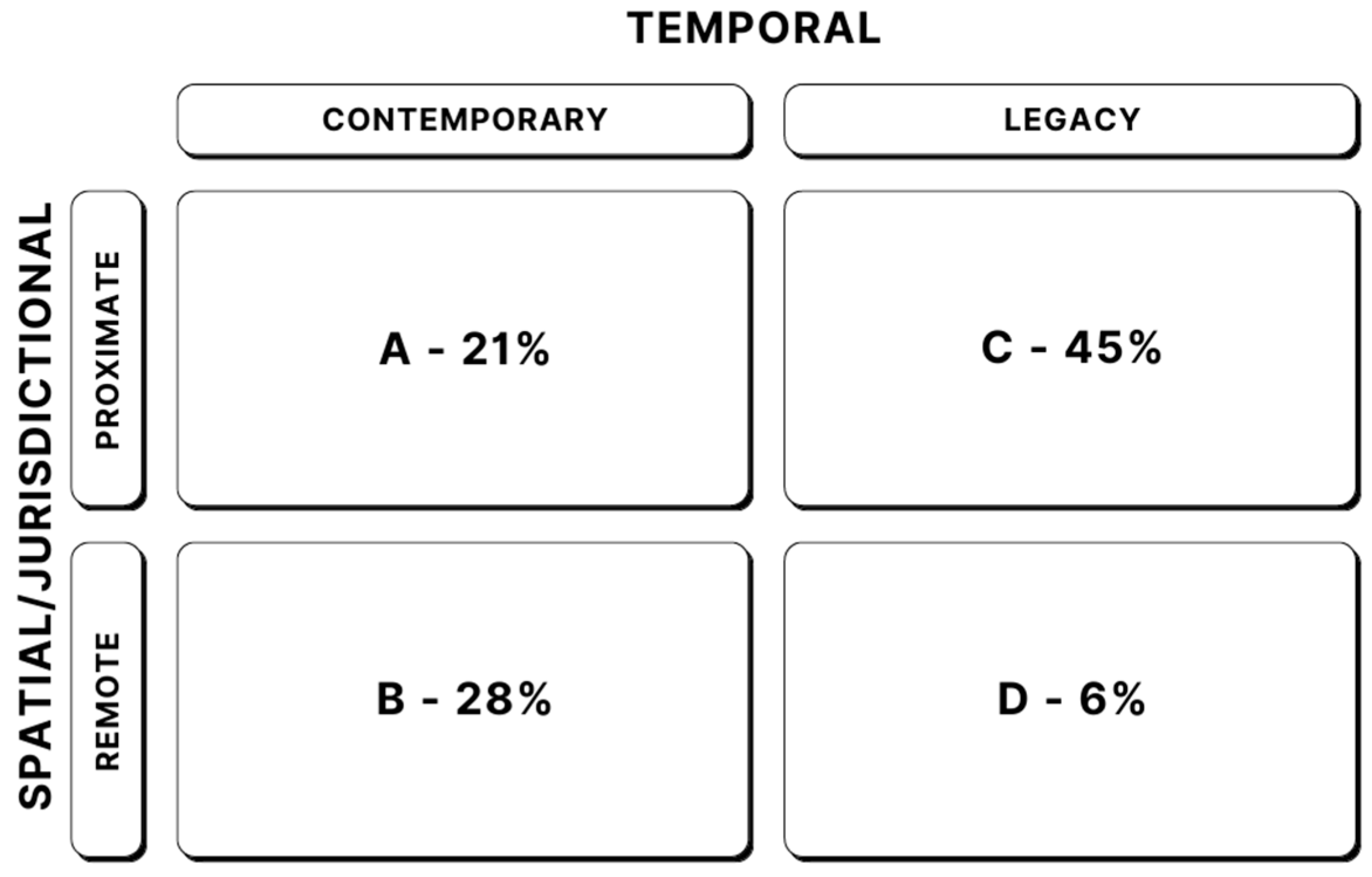
| Title | Government Level |
|---|---|
| Youth Environmental Coordinator | District/Local |
| District and Local Government support—Environmental Management | District/Local |
| Executive Director—Community Services | District/Local |
| Youth Environmental Coordinator | District/Local |
| District Manager—Environmental Management | Provincial |
| Control Environmental Officer | Provincial |
| Climate Change Intern | Provincial |
| Climate Change Specialist | National |
| Chief Director—Climate Change Adaptation | National |
| Control Environmental Officer | National |
| Director of Adaptive Capacity Programme | National |
| Director—Climate Change Adaptation | National |
| Director—Climate Change Adaptation | National |
| Understanding | Planning | Implementation and Monitoring |
|---|---|---|
| Limited understanding of climate change issues by communities | Not enough climate change plans in place at the local level | Inadequate financial resources |
| Limited political will | Lack of human resources | |
| Lack of climate change knowledge by some staff members tasked with environmental duties | Inadequate coordination across government levels and sectors | |
| No climate change unit at the local level | ||
| No legal mandate at the local level | ||
| Outdated information on climate change issues used in the IDPs | ||
| Barriers | National Level DFFE | Provincial Level KZN EDTEA | District/Local Level UKDM |
|---|---|---|---|
| Inadequate financial resources | X | X | X |
| Lack of human resources | X | X | |
| Limited political will | X | ||
| Limited understanding of climate change issues by communities | X | ||
| Inadequate coordination | X | X | X |
| No legal mandate | X | ||
| No climate change unit | X | ||
| Lack of climate change knowledge by some staff members tasked with environmental duties | X | ||
| Not enough climate change plans | X | ||
| Outdated information on climate change issues used in the IDPs | X |
Disclaimer/Publisher’s Note: The statements, opinions and data contained in all publications are solely those of the individual author(s) and contributor(s) and not of MDPI and/or the editor(s). MDPI and/or the editor(s) disclaim responsibility for any injury to people or property resulting from any ideas, methods, instructions or products referred to in the content. |
© 2023 by the authors. Licensee MDPI, Basel, Switzerland. This article is an open access article distributed under the terms and conditions of the Creative Commons Attribution (CC BY) license (https://creativecommons.org/licenses/by/4.0/).
Share and Cite
Sibiya, N.P.; Das, D.K.; Vogel, C.; Mazinyo, S.P.; Zhou, L.; Kalumba, M.A.; Sithole, M.; Adom, R.K.; Simatele, M.D. Overcoming Bureaucratic Resistance: An Analysis of Barriers to Climate Change Adaptation in South Africa. Climate 2023, 11, 145. https://doi.org/10.3390/cli11070145
Sibiya NP, Das DK, Vogel C, Mazinyo SP, Zhou L, Kalumba MA, Sithole M, Adom RK, Simatele MD. Overcoming Bureaucratic Resistance: An Analysis of Barriers to Climate Change Adaptation in South Africa. Climate. 2023; 11(7):145. https://doi.org/10.3390/cli11070145
Chicago/Turabian StyleSibiya, Nomfundo Patricia, Dillip Kumar Das, Coleen Vogel, Sonwabo Perez Mazinyo, Leocadia Zhou, Mukalazi Ahmed Kalumba, Mikateko Sithole, Richard Kwame Adom, and Mulala Danny Simatele. 2023. "Overcoming Bureaucratic Resistance: An Analysis of Barriers to Climate Change Adaptation in South Africa" Climate 11, no. 7: 145. https://doi.org/10.3390/cli11070145
APA StyleSibiya, N. P., Das, D. K., Vogel, C., Mazinyo, S. P., Zhou, L., Kalumba, M. A., Sithole, M., Adom, R. K., & Simatele, M. D. (2023). Overcoming Bureaucratic Resistance: An Analysis of Barriers to Climate Change Adaptation in South Africa. Climate, 11(7), 145. https://doi.org/10.3390/cli11070145








